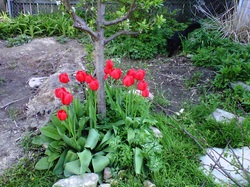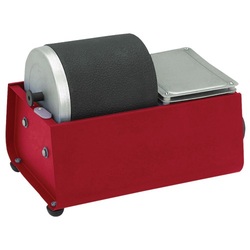 I’ve been asked if I could adapt my love of making chainmaille to making items that are “useful” rather than simply decorative. I admit that I like the idea of creating useful objects, and I’ve seen lovely pieces that I hope to try my hand at sometime, articles of clothing, purses/bags, and even baskets made of chainmaille. Other usable items include candle-skirts and pot-scrubbers, although I’m not sure I want to devote the time it takes to weave metal rings for a pot-scrubber unless I had no other way to obtain one. Despite the value of “useful”, there is much to be said for something that is simply beautiful. It’s said that the experience of "beauty" often involves an interpretation of something being in balance and harmony with nature, which may lead to feelings of attraction and emotional well-being. Perhaps this is why we humans appreciate so many forms of self-adornment. Whether it’s fashionable clothing, jewelry, hairstyle trends, or tattoos and piercings, we are a flashy species and we spend a lot of time and money decorating ourselves. This is because what we perceive as beauty feeds something inside us that goes beyond simple vanity or being noticed. Surrounding ourselves with the things we think are beautiful, whether it’s a jar of flowers and native grasses from the yard, a piece of fine art, or a bracelet accented with handmade beads, can be a treat for the soul as well as the eyes. I recall a coworker’s son who, when he was small, always wore a ring I’d made him to school, his “Prince Ring”, because he said he felt good when he wore it. I will one day try my hand at creating “practical”, “useful” items, but in addition I intend to enjoy making things that make me feel good and that hopefully make the people who wear them feel good. “A thing of beauty is a joy for ever: Its loveliness increases; it will never Pass into nothingness; but still will keep A bower quiet for us, and a sleep Full of sweet dreams, and health, and quiet breathing.” –John Keats
0 Comments
 Some of you may be able to relate to the struggle of finding enough time to create. Family, friends, pets, shopping and cooking, 9-5 jobs and other work all demand a large chunk of time when added together. (You will notice that I don’t even count housework in this mix…) I never seem to have as much time as I’d like for working on the ideas I have while meeting a lot of the other demands on my time. I tend to view the process of creating as a “reward” or a leisure activity, because even when it’s challenging, difficult, or even frustrating, I love it so much. So I usually feel like I have to “earn” that time by making sure that my immediate chores are done (dishes, laundry, grocery shopping, cooking) and all other demands are met before I can turn my full attention to the jewelry. By then it’s usually late in the day and even if I’m not physically exhausted, I’m not as alert and at my best. I end up working on something simple or organizing some workspace, and this makes me resent the other things in my life. Not good… So, what to do? One of the things I’ve found helpful, and I know artists who do this consistently, is to schedule the time for creating as “work time”. I know we might not be used to thinking of work as something we love to do, would rather do than sleep or eat, but whether you make jewelry, melt glass, knit, paint, or write, you know how much of yourself you put into what you create, and you know how hard you work. I’ve scheduled 3-4 hours this afternoon to work on putting together some jewelry designs that have been running around in my head. Then I’ll fix dinner, clean up, attend a studio Opening for a friend, and, if I’m not too spent afterward I will work a little more when I get home, until bed time. Scheduling the time might seem like a simple concept, but it has evaded me, and I find it helpful when I remember to do it. Another good, and sometimes easier-for-me option, is to take advantage of “Open Studio” time. Many stores/suppliers, like Funky Hannah’s bead store in Racine, WI and Blue Buddha Boutique in Chicago, IL have free, Open Studio time in their calendars, where anyone can bring something to work on and spend a few hours with others, working on individual projects. These are not classes, and you shouldn’t expect an instructor to be teaching anything, but I’ve found that other artists are often very helpful if you get stuck or need some advice. It’s a great way to spend time working on what you like to do with other people who are doing the same. Another plus is that when you are at an Open Studio, it’s probable that nobody is going to interrupt you to ask if you know where they left their hat, or if there’s anything to eat.  Recently a new chainmailler asked about using a tumbler to clean and polish rings. A tumbler either spins (rotary) or vibrates with some kind of polishing medium, such as stainless steel shot and a cleaning solution. I'd had the same question when I started, because some of the metals I use tarnish or patina over time when exposed to the air. A friend and experienced mailler had recommended to me the inexpensive tumbler above to start with. It's under $50 and easy to use. She also recommended washing copper and brass pieces in ketchup, letting them soak for a while and "smooshing" it all around before washing with detergent and rinsing. Before I was ready to invest in the tumbler, I tried the ketchup bath, and it worked. So did lemon juice and vinegar. Tumbling can produce a "like new" shine, and it's great for "hardening" metal with the rotary action, but most of the time I go for the low-tech option and for touch-ups, a little ketchup bath works fine. |
Hi, I'm Hannah Medrow
I spend most of my time weaving metal rings, working with metal or thinking about working with metal. I'm also an occasional activist. I have strong opinions about a lot of things, but mostly I like to share information. Hopefully I will be able to share useful information here. Feel free to chime in if you have something to share. Archives
March 2016
Categories
All
|

 RSS Feed
RSS Feed